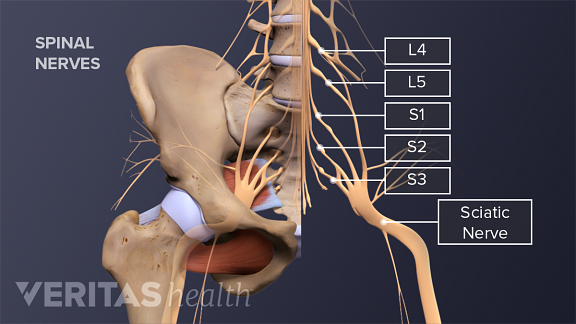Sciatica is a pain centered in the iliococcygeal region of the body, specifically along the path of the sciatic nerve. This nerve travels along a person's lower back, through the hips, buttocks, and down the posterior leg. Whether sharp or dull, or a fast jolt or a long-burning problem, it is frequently exacerbated by long periods of sitting, and often only occurs on one side at a time.
Sciatica itself in fact describes the symptom that is that pain, rather than a specific condition.

There are no given pre-conditions for sciatica, but it primarily occurs when the sciatic nerve becomes trapped, ultra-compressed, or pinched. Potential causes of this nerve entrapment include:
Sedentary lifestyle, especially if it includes sitting in one position for long periods
Long or frequent periods of work that require carrying heavy loads and over twisting the spine
Diabetes, due to increased risk of nerve damage
Herniated disk (aka ruptured intervertebral disk)
Bone spurs on the spine
Pelvic fracture injury
Spinal stenosis (narrowing of the spine)
In pregnant folk, heavy lifting should be avoided regardless, but recommendations will include to lie on the side opposite the pain, to avoid long periods spent standing, and to consider swimming as an exercise.
Massage and Sciatica:
Massage is extremely beneficial for those experiencing sciatica. Most commonly, the root cause involves muscles pinching the sciatic nerve; in these cases, the relaxation, tension relief, and increased blood flow and even range of motion and flexibility with the right techniques will relieve the pain for some time, if not alleviate the symptom altogether. Endorphin release as a direct result of general massage work also helps manage pain of all kinds, and will likewise provide relief. Swedish, deep tissue, neuromuscular, myofascial release, thai yoga massage, and hot stone massages are all viable techniques.
Massage is contraindicated for sciatica usually only dependent upon the originating root cause; in the case of a herniated disk, there may be regional contraindications. Refer to a doctor in such a case, or in the case of sciatica as symptom of any degenerative or other significant spine condition, or in the case of injury.
======
From a Western perspective:
Mild sciatica often goes away over time. If symptoms last more than a week, or becomes severe or debilitating, people will largely be advised to seek their doctor’s help; immediate attention should be sough in particular if the pain follows a violent injury, bowel control becomes difficult, or sudden severe pain in the low back or leg or muscle numbness occurs.
Most often, for mild sciatica, self-care will be prescribed; this usually includes gentle stretches, care taken to be hydrated and to eat well, and recommendations to increase the level of gentle but regular exercise, particularly exercise that will work the legs and hips.
Acetaminophen may be recommended as a temporary pain relief when needed, in moderation.
In addition, more and more doctors and chiropractors alike will recommend massage for clients experiencing back pain, for not only relaxation and easement of pain, but to specifically help loosen the muscles that may be pinching the sciatic nerve and causing the pain.
======
From an Eastern perspective:
There is no referenceable, reliable first-hand information in research papers or otherwise about treating sciatica from the perspective of TCM (Traditional Chinese Medicine), but many accounts refer to the matters of Yin & Yang and the Five Elements for insight into what might be done for a person experiencing sciatica. It may be considered a Water (Kidney) or Wood (Liver) imbalance in the Five Element system.
If the pain is hot, inflamed, sharp, then that could indicate an excessive amount of Yang energy; to contrast, if the pain is cold, dull, aching, then that could signal Yin energy in excess. Methods to balance this energy out may then be recommended by a TCM practitioner, including but not limited to certain Qi Gong moves, meditation, or breathing exercise. There may also be reference to a blockage of qi, which might occur at the site of pain. This would also be followed up by methods of movement, breathing, acupuncture treatments, tui na treatments, or even certain herb formulas as appropriate.
Though in general TCM herb treatments come in groups and blends tailor made for the client, a few potential herbs that might be recommended include Du Huo (Angelica pubescentis), Du Zhong (Eucommia), and Dang Gui (Radix Angelica Sinensis).
Du Huo is reported to strengthen the Kidney (Water element) system, and to thus relieve achy back pain. [May cause uterine contractions; people should not take if possibly pregnant. May cause excessive skin sensitivity in sunlight if applied topically. May be anti-inflammatory, so user should beware any contraindications with current medications.]
Du Zhong is reported to generally strengthen and support the body, and generally clear inflammation and ease pain. [May contain toxic compounds or heavy metals. Highly advised against for those using diabetes medications, high blood pressure medications, anticoagulants, antiplatelets, or thrombolytics. Contraindicated in people diagnosed with estrogen-dependent cancers.]
Dang Gui, also known as “women’s herb”, is reported to strongly assist in improving circulation and propagate nourishment of the blood. [Contains substances that are known to cause cancer. Also not recommended for those with Protein S deficiency. Should not be taken with blood clotting medications. Can prevent blood clotting.]
======================
Sources:
https://www.mayoclinic.org/diseases-conditions/sciatica/symptoms-causes/syc-20377435?p=1
https://medlineplus.gov/sciatica.html
https://www.spine-health.com/conditions/sciatica/what-you-need-know-about-sciatica
https://www.sciatica-pain.org/traditional-chinese-medicine-for-sciatica.html
https://www.healthline.com/health/massage-for-sciatica
https://bestchinesemedicines.com/collections/back-pain-sciatica/
https://medicinalherbals.net/dang-gui/
https://www.drugs.com/npp/du-zhong.html
https://www.verywellhealth.com/what-you-need-to-know-about-eucommia-88939
https://www.webmd.com/vitamins/ai/ingredientmono-281/angelica
https://www.meandqi.com/herb-database/pubescent-angelica-root





No comments:
Post a Comment